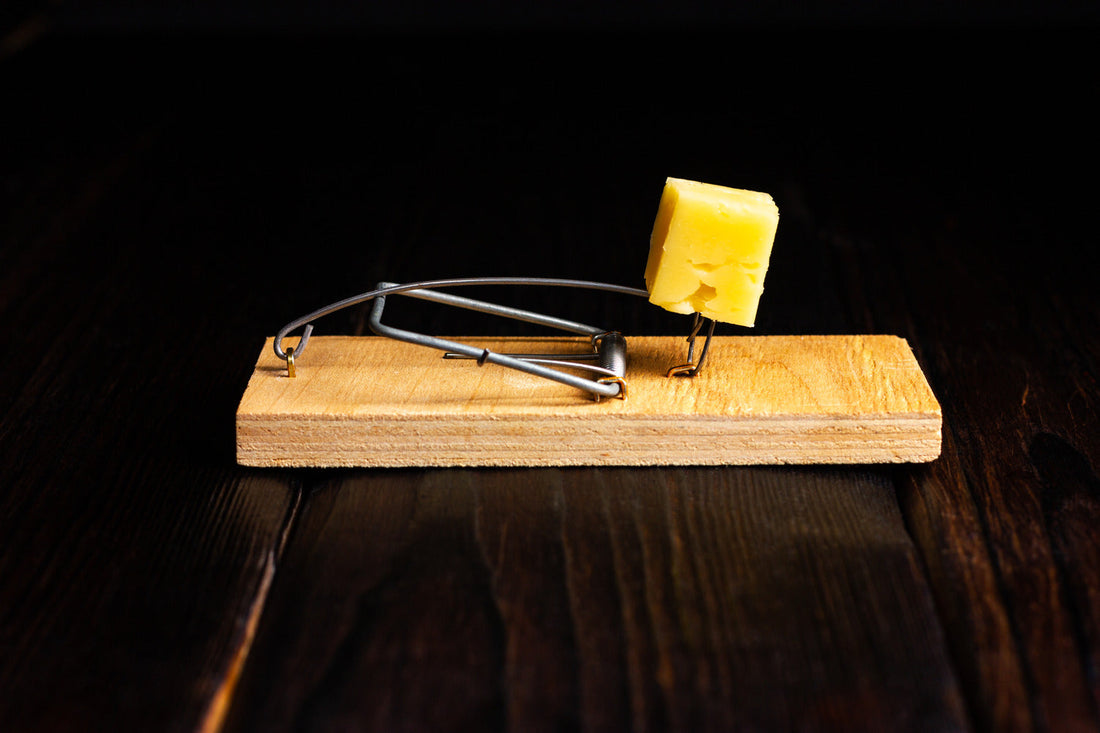
Where to Put Mouse Traps for Best Results
Share
The worst part about finding a mouse in your house is the realization that there are almost definitely more. Mice reproduce at a staggering pace, so a small problem can balloon into a full-blown infestation in just a matter of weeks. Acting quickly is key — but even the best mouse trap won’t work if it’s not set up properly.
In this guide, we’ll break down not only where to put your mouse traps for best results but how to set them up, what bait to use, and how to keep mice from ever coming back.
What Type of Mouse Trap Should You Use?
Since the establishment of the US Patent Office in 1838, no other invention has been awarded more patents than the mouse trap (over 4,400), and still … the classic snap trap has withstood the test of time for a reason — it works.
Simple, affordable, and easy to set up, snap traps will always remain an effective tool.
Where to Put Mouse Traps
To put it in the simplest of terms: where the mice are.
Start by looking for signs of activity:
- Droppings along baseboards or behind furniture
- Gnaw marks on cardboard, wires, or food packaging
- Greasy rub marks along walls
- Noises at night in walls, ceilings, or under floors
While mice are skittish creatures, they are also quite curious. In fact, they are far more likely to investigate new objects (traps included) than rats. But they’d prefer to do so from a place of comfort.
When placing your traps, begin by setting them up where mice have already shown themselves happy to be.
Ideal Locations for Mouse Traps:
- Along walls: Mice tend to hug walls rather than venture into open spaces. Place traps perpendicular to the wall, with the baited end facing the wall.
- Behind appliances: Warm, sheltered spaces behind stoves, fridges, and washing machines are mouse hotspots.
- Inside cabinets & pantries: Especially if food is stored there. Look for droppings or chewed packaging.
- Near entry points: Check for gaps in baseboards, vents, or around pipes. Mice often travel the same routes.
Important: Avoid placing traps in open, central areas — mice prefer tight, sheltered spaces where they feel safe to explore.
Tips for Setting Up a Mouse Trap
Knowing where to place your mouse trap is just the start. To actually catch a mouse, the setup matters. Here are some tips:
- Wear gloves: Human scent can make mice avoid a trap. Use gloves when handling both the trap and bait.
- Use a sheltering setup: Mice are more likely to approach a trap if it feels like a safe, enclosed space. Try placing it inside a cut shoebox or between objects that mimic a tunnel.
- Anchor your traps: A mouse can sometimes drag a trap away if it’s not secured. Use double-sided tape or secure the trap against a wall or baseboard.
- Go big on night one: Studies show that the first night of trapping is often the most successful. Set multiple traps at once to maximize your chances.
- Check daily: Reset or replace traps frequently. A used trap can become ineffective quickly.
What is the Best Bait for Mouse Traps?
Ignore the Saturday morning cartoons — mice aren’t actually that into cheese. The best bait options are sticky, high-protein foods they can smell from afar:
- Peanut butter or nut butters (top pick)
- Chocolate
- Bacon bits
- Small chunks of granola or seeds
Important: Only use a small dab — about the size of a pea. Too much bait, and the mouse might steal it without triggering the trap.

How Many Mouse Traps Should You Set?
The more, the better.
Mice are curious but cautious. Multiple traps increases your chance of catching them before they become “trap shy.” Even if you’ve only seen one mouse, start by setting up 5-10 traps, depending on the size of your space
Here are some quick guidelines:
- Small apartment or single room: 4–6 traps
- Single-family home: 8–12 traps
- Larger properties or suspected infestations: 15+ traps, especially in hotspots like kitchens, garages, and attics
Different Types of Mouse Traps — and When to Use Them
While snap traps are the go-to choice, here’s a quick overview of other types:
| Trap Type | How It Works | When to Use |
|---|---|---|
| Snap Trap | Classic bar-style trap that kills instantly | General use; quick, effective, reusable |
| Electric Trap | Delivers fatal shock upon entry | Clean, enclosed kill; good for homes with pets or kids |
| Glue Trap | Sticky surface immobilizes the mouse | Use only as a last resort; often inhumane and messy |
| Live-Catch Trap | Catches mouse without harm | Only if you can release mouse 2+ miles away |
| Bait Station | Mouse enters to consume poison bait | Serious infestations; best for outdoor use (keep away from pets) |
How to Prevent Mice from Returning to Your Home
Trapping and removing mice is only the first step. To truly combat an infestation, you’ll need to address the reason why mice came in the first place.
Here are essential preventative measures to keep mice out of your home for good:
- Seal all entry points: Use steel wool or caulk to fill holes larger than ¼ inch around pipes, vents, and baseboards.
- Keep food sealed: Store grains, snacks, and pet food in airtight containers.
- Declutter: Cardboard boxes and storage bins offer great hiding spots.
- Clean up crumbs: Especially in hard-to-reach spots like behind the stove.
- Set a barrier: The Box-Kat mouse barrier protect vehicles, homes, and storage areas by blocking entry entirely.

Stop Fighting Mice — Box-Kat is Your Long-Term Solution
Knowing where to put mouse traps can make the difference between solving your mouse problem overnight… or letting it multiply. With smart placement, proper baiting, and follow-up prevention, you can tackle mice quickly and confidently.
Want a more permanent solution for your garage, RV, or shed? Check out the Box-Kat — a patented barrier system designed to keep mice out for good.



